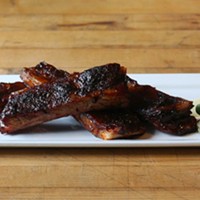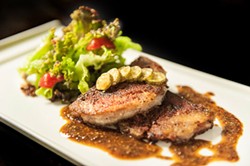The smell in the well-chilled room was unmistakably death. Blood, copious amounts of it, bears a certain stench that is hard to forget. I stood on the kill floor at Mays Meats, a meat processing facility in Taylorsville, N.C, wearing a hairnet and an oversized white coat that looked particularly clownish on my 5'3" frame. I could hear the chute, opening and closing with industrial force, the sound of the captive bolt stunner and then, death.
The hog I had helped to load the day before at Grateful Growers Farm was strung up, its massive body cut and quickly bled out. A team of four worked quickly to remove the skin, eviscerate the pig and saw it in half. Slaughtering an animal isn't pretty, but there is one way its life can be honored. Eat the whole thing.
Snout-to-tail eating, the act of eating all parts of the animal, is not a new trend. Early U.S. records of eating the "nasty bits" dates back to slavery in the South. Hog maws, chitterlings and pigs' feet were considered "survival food" and were the least desirable parts of the animal — therefore, available to the poor. Cooking them required skill, care and careful seasoning.
As history is wont to do, the old becomes new again, and low food transformed into haute cuisine. Fergus Henderson, a British chef and owner of the London restaurant St. John, unofficially launched the snout-to-tail movement in high-end restaurants in the United States with the release of his 2004 book, The Whole Beast: Nose to Tail Eating, a classic cooking tome that explores the preparation of the entire animal.
In Charlotte, snout-to-tail preparations in restaurants are just now beginning to appear more regularly on a select few menus.
At 5Church, executive chef Jamie Lynch is diving head first into whole beast cooking. Literally. On my last visit, I reveled in his latest creation, a seared pig's head torchon. The torchon, which means "towel" in French, is a classic preparation. In this case, meat from the pig's head is combined with silky fat, bits of brain and ears and then wrapped tightly together into a tubular mass, poached, and then hung to compress its contents. The resulting delicacy is sliced into patties that were then seared on each side. Though it may sound a bit like souse meat, the torchon maintained a distinct meatiness rather than the congealed texture of its jellied brethren.
The dish was served with a crisp sliver of bread, Mexican gherkins, mustard jus and local greens. The flavor was unbelievably smoky and the prized fat from the head weaved a decadent and rich thread throughout the torchon.
Other dishes coming out of the 5Church kitchen include pork belly, roasted pork steamed bun, pig's heart carpaccio, stuffed pigs' feet and lardo.
"If we bring in the whole pig, we gotta use the whole pig," Lynch says.
Lynch is adamant about respecting the animal. He was first exposed to whole beast cooking when he worked in professional kitchens in New York. When he returned to North Carolina, he began connecting with farmers, voluntarily working on farms and learning the process of how an animal makes it from the farm to plate.
"[Working on a farm] solidified my craft and introduced me to the responsibility we have as chefs to take care of the whole animal," he says.
Lynch uses every part of the animal imaginable with great care. But, he says, though the Charlotte crowd enjoys his creations, they still don't want to know what they are eating.
An informal poll generated a similar consensus from other chefs. How a dish is worded on the menu is just as important as skilled preparation. Chef Cassie Parsons of Farmer, Baker, Sausage Maker remembers when she tried out a liver mush dish as a special.
"It was hilarious," says Parsons. "We could barely move any when we left the word 'liver' in the menu description, but when we took it off, it sold."
Chef Frank Altomare of Aria Tuscan Grill had similar experiences when trying to introduce sweetbreads (the thymus and throat glands of an animal) to the bar menu. It just didn't take off.
However, Altomare's five-course "Nose to Tail" dinners, a new experience offered at Aria, have been successful. Altomare works with sucklings, young pigs approximately 35 pounds or less, and stresses the importance of wasting nothing, a sentiment he learned early from his Italian family.
"I grew up knowing that something was born, raised and grown for a purpose and that it was to be respected from start to finish," he says.
For Altomare, the process of cooking snout to tail invigorates his creativity in the kitchen. He has made everything from trotter jam to pork rillettes and even a zeppole batter made from dehydrated pigs ears.
So, how popular is the nose-to-tail trend in Charlotte? It's hard to tell. Carolyn Erickson, co-leader for the Charlotte chapter of the Westin A. Price Foundation, offered a workshop for those interested in cooking snout to tail, which she had to cancel due to lack of interest.
Well, maybe no squeals of excitement from the masses yet, but it appears something offal this way comes.
Speaking of...
-

TRAP Karaoke Is a Thing, and I'm Here For It
May 24, 2017 -
Best Restaurant in Uptown
Sep 30, 2015 -

Eat This: Poppy’s Bagel with Lox and Cream Cheese
May 21, 2015 - More »
Latest in Food & Drink Features
More by Keia Mastrianni
-

Eat this: Korean Fried Chicken at Kindred Restaurant
Aug 19, 2015 -

Eat This: Border springs lamb ribs at Bonterra
Jun 23, 2015 -

The Big Reveal: What's replacing the Penguin?
Apr 8, 2015 - More »
Calendar
-

Aria Tuscan Grill Featuring Allegrini - Charlotte Wine + Food Week @ Aria Tuscan Grill
-

Angeline’s Featuring Sciandri Family Vineyards @ Angeline's
-

Charlotte Wine + Food Week Presented by Truist @ Charlotte, NC
-

Cakeable Cafe Grand Opening @ Cakeable Cafe
-

Haw River Wine Tasting @ Carolina Beer Temple.
-
Authentic New York-style Bagels Come to South End 1
Poppy's expands its empire
-
Dorie Greenspan's Tiramisu Cake
This layered cake is definitely a "pick-me-up" with a little booze and caffeine.
-
Eating With Your Dollars: The best fast food money can buy 14
The Food Babe talks juicing.













